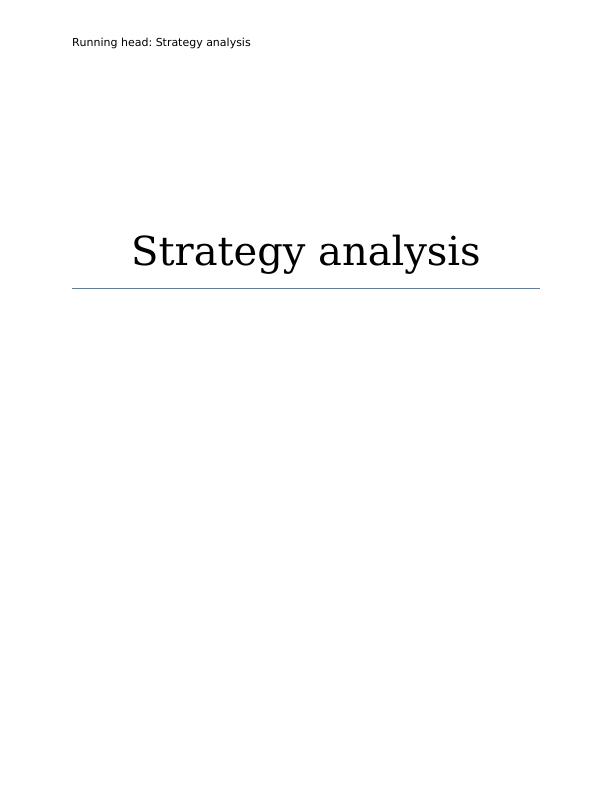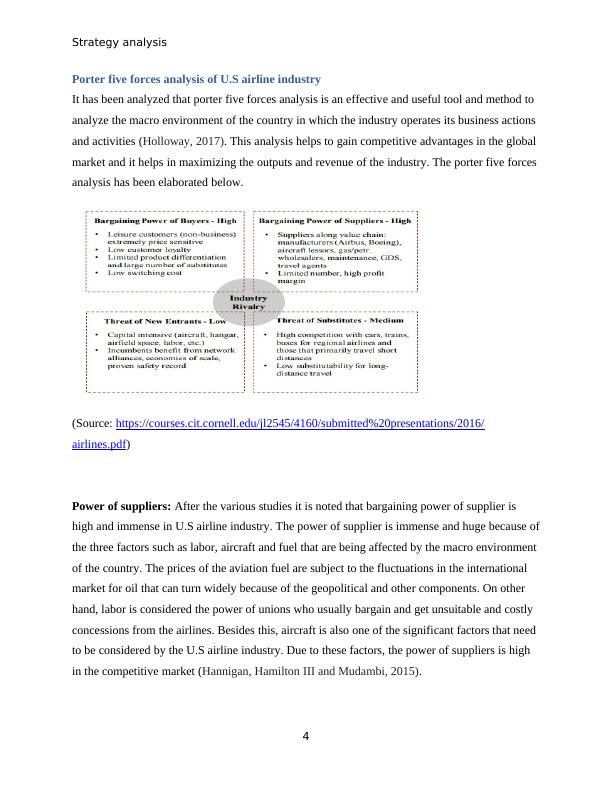US Airline Strategy Analysis
Added on 2021-06-15
12 Pages3421 Words22 Views
Running head: Strategy analysis
Strategy analysis
Strategy analysis

Strategy analysis
Table of Contents
Introduction.................................................................................................................... 3
Overview of the U.S airline industry..................................................................................... 3
Porter five forces analysis of U.S airline industry.....................................................................4
Economic performance...................................................................................................... 6
Strategies for airline industry.............................................................................................. 7
Discussion..................................................................................................................... 9
Conclusion..................................................................................................................... 9
References................................................................................................................... 11
2
Table of Contents
Introduction.................................................................................................................... 3
Overview of the U.S airline industry..................................................................................... 3
Porter five forces analysis of U.S airline industry.....................................................................4
Economic performance...................................................................................................... 6
Strategies for airline industry.............................................................................................. 7
Discussion..................................................................................................................... 9
Conclusion..................................................................................................................... 9
References................................................................................................................... 11
2

Strategy analysis
Introduction
The main motive of this paper is to explain and outline the business operations and activities of
the U.S airline industry. The U.S airline industry is growing and leading industry in today’s
competitive world. The paper explains that how the industry uses porter five forces analysis to
overcome and handle the competitors. Besides this, business strategies and economic
performance of the industry have been explained in detail in the task.
Overview of the U.S airline industry
The U. S airline industry is remains in the midst of an historic restructuring. Over the last five
years, the U.S airline industry has eliminated their annualized mainline costs and expenses
excluding fuel by more than 25% or nearly $20 billion. The airline industry is focuses on the
labor, fuel, customer service, external distribution, commission, pension and maintenance. It has
been noted that United States has an extensive and large air transportation network. It has been
analyzed that there were 86 airports in the United States that managed and handled the more than
1, 00,000 passengers in 2013. The main mission of the U.S airline industry is to provide air
services to the passenger at cheaper prices to win and capture the entire market. Along with this,
the vision of the company is to increase and enhance the profitability and revenue by rendering
unique air services to the passengers across the world (Johnston and Ozment, 2013). It has been
revealed that U.S airline industry is struggling to earn profit and revenue. Apart from this, the
industry focuses on the plans, policies and strategies of the competitors to gain competitive
advantages in the market. To attain long term goals and objectives, the industry focuses on the
needs, preferences and tastes of the consumers. It will also help to attract and maximize the
number of passengers in the marketplace. Delta and northwest merged in 2008 and united and
continental merged in 2010. PESTLE analysis is done by the industry to know and understand
the opportunities and threats of the marketplace. The pestle analysis includes political, economic,
legal, environmental, socio-cultural and technological factors (Belobaba, Odoni and Barnhart,
2015).
3
Introduction
The main motive of this paper is to explain and outline the business operations and activities of
the U.S airline industry. The U.S airline industry is growing and leading industry in today’s
competitive world. The paper explains that how the industry uses porter five forces analysis to
overcome and handle the competitors. Besides this, business strategies and economic
performance of the industry have been explained in detail in the task.
Overview of the U.S airline industry
The U. S airline industry is remains in the midst of an historic restructuring. Over the last five
years, the U.S airline industry has eliminated their annualized mainline costs and expenses
excluding fuel by more than 25% or nearly $20 billion. The airline industry is focuses on the
labor, fuel, customer service, external distribution, commission, pension and maintenance. It has
been noted that United States has an extensive and large air transportation network. It has been
analyzed that there were 86 airports in the United States that managed and handled the more than
1, 00,000 passengers in 2013. The main mission of the U.S airline industry is to provide air
services to the passenger at cheaper prices to win and capture the entire market. Along with this,
the vision of the company is to increase and enhance the profitability and revenue by rendering
unique air services to the passengers across the world (Johnston and Ozment, 2013). It has been
revealed that U.S airline industry is struggling to earn profit and revenue. Apart from this, the
industry focuses on the plans, policies and strategies of the competitors to gain competitive
advantages in the market. To attain long term goals and objectives, the industry focuses on the
needs, preferences and tastes of the consumers. It will also help to attract and maximize the
number of passengers in the marketplace. Delta and northwest merged in 2008 and united and
continental merged in 2010. PESTLE analysis is done by the industry to know and understand
the opportunities and threats of the marketplace. The pestle analysis includes political, economic,
legal, environmental, socio-cultural and technological factors (Belobaba, Odoni and Barnhart,
2015).
3

Strategy analysis
Porter five forces analysis of U.S airline industry
It has been analyzed that porter five forces analysis is an effective and useful tool and method to
analyze the macro environment of the country in which the industry operates its business actions
and activities (Holloway, 2017). This analysis helps to gain competitive advantages in the global
market and it helps in maximizing the outputs and revenue of the industry. The porter five forces
analysis has been elaborated below.
(Source: https://courses.cit.cornell.edu/jl2545/4160/submitted%20presentations/2016/
airlines.pdf)
Power of suppliers: After the various studies it is noted that bargaining power of supplier is
high and immense in U.S airline industry. The power of supplier is immense and huge because of
the three factors such as labor, aircraft and fuel that are being affected by the macro environment
of the country. The prices of the aviation fuel are subject to the fluctuations in the international
market for oil that can turn widely because of the geopolitical and other components. On other
hand, labor is considered the power of unions who usually bargain and get unsuitable and costly
concessions from the airlines. Besides this, aircraft is also one of the significant factors that need
to be considered by the U.S airline industry. Due to these factors, the power of suppliers is high
in the competitive market (Hannigan, Hamilton III and Mudambi, 2015).
4
Porter five forces analysis of U.S airline industry
It has been analyzed that porter five forces analysis is an effective and useful tool and method to
analyze the macro environment of the country in which the industry operates its business actions
and activities (Holloway, 2017). This analysis helps to gain competitive advantages in the global
market and it helps in maximizing the outputs and revenue of the industry. The porter five forces
analysis has been elaborated below.
(Source: https://courses.cit.cornell.edu/jl2545/4160/submitted%20presentations/2016/
airlines.pdf)
Power of suppliers: After the various studies it is noted that bargaining power of supplier is
high and immense in U.S airline industry. The power of supplier is immense and huge because of
the three factors such as labor, aircraft and fuel that are being affected by the macro environment
of the country. The prices of the aviation fuel are subject to the fluctuations in the international
market for oil that can turn widely because of the geopolitical and other components. On other
hand, labor is considered the power of unions who usually bargain and get unsuitable and costly
concessions from the airlines. Besides this, aircraft is also one of the significant factors that need
to be considered by the U.S airline industry. Due to these factors, the power of suppliers is high
in the competitive market (Hannigan, Hamilton III and Mudambi, 2015).
4

End of preview
Want to access all the pages? Upload your documents or become a member.
Related Documents
Strategy and Case Analysis of US Airline Industrylg...
|16
|3478
|84
Strategy and Case Analysis Assignment - DOClg...
|14
|3529
|258
The Marketing Strategy of the Airline | Case Studylg...
|21
|5235
|96
Business Environment of Ryan Airlg...
|22
|4934
|63
Strategic Management Analysislg...
|17
|4383
|80
Competitive Advantage of American Airline Industrylg...
|17
|3878
|139
